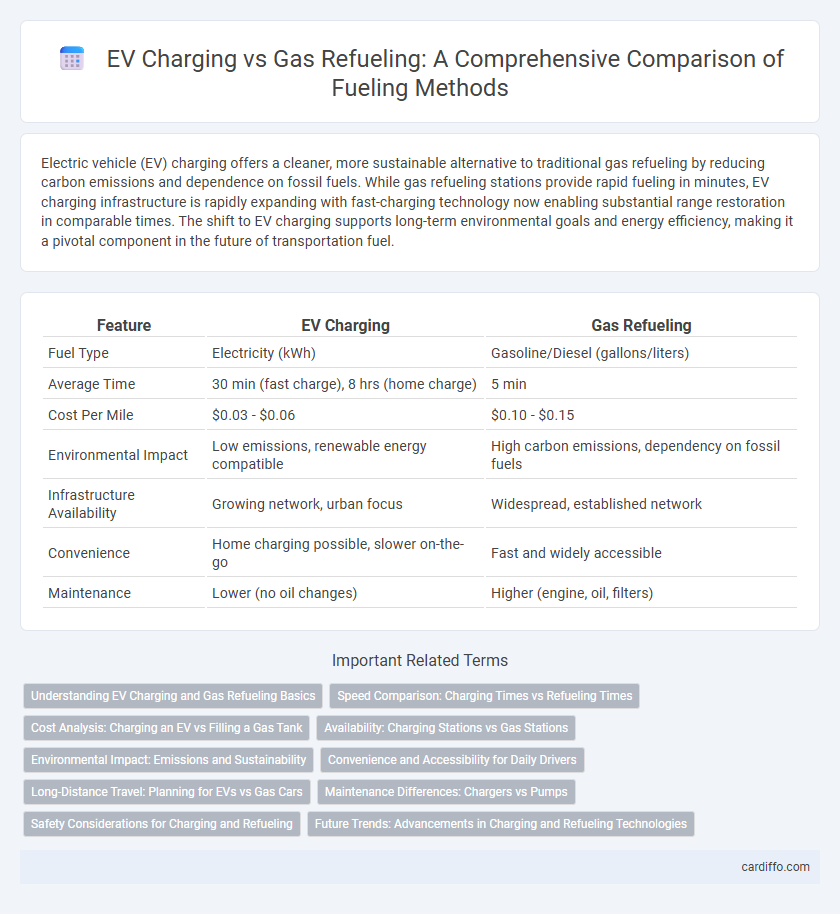Electric vehicle (EV) charging offers a cleaner, more sustainable alternative to traditional gas refueling by reducing carbon emissions and dependence on fossil fuels. While gas refueling stations provide rapid fueling in minutes, EV charging infrastructure is rapidly expanding with fast-charging technology now enabling substantial range restoration in comparable times. The shift to EV charging supports long-term environmental goals and energy efficiency, making it a pivotal component in the future of transportation fuel.
Table of Comparison
| Feature | EV Charging | Gas Refueling |
|---|---|---|
| Fuel Type | Electricity (kWh) | Gasoline/Diesel (gallons/liters) |
| Average Time | 30 min (fast charge), 8 hrs (home charge) | 5 min |
| Cost Per Mile | $0.03 - $0.06 | $0.10 - $0.15 |
| Environmental Impact | Low emissions, renewable energy compatible | High carbon emissions, dependency on fossil fuels |
| Infrastructure Availability | Growing network, urban focus | Widespread, established network |
| Convenience | Home charging possible, slower on-the-go | Fast and widely accessible |
| Maintenance | Lower (no oil changes) | Higher (engine, oil, filters) |
Understanding EV Charging and Gas Refueling Basics
EV charging involves replenishing a vehicle's battery through electric power sources, typically classified as Level 1, Level 2, or DC fast charging, with charging times ranging from 30 minutes to several hours depending on the charger type and battery capacity. Gas refueling requires pumping gasoline or diesel fuel into an internal combustion engine vehicle's tank, a process that generally takes less than five minutes at standard gas stations. Understanding these fundamental differences highlights the convenience and time investment unique to each fuel method, influencing consumer choices based on availability, speed, and infrastructure.
Speed Comparison: Charging Times vs Refueling Times
EV charging times vary significantly depending on the charger type, with Level 1 home chargers taking up to 12-24 hours, Level 2 chargers requiring 4-8 hours, and fast DC chargers providing 80% charge in about 20-40 minutes. In contrast, gas refueling an internal combustion engine vehicle typically takes 5-10 minutes, offering a clear advantage in speed for traditional fueling. However, improvements in fast-charging infrastructure and battery technology continue to reduce EV charging times, narrowing the gap between electric and gas refueling speeds.
Cost Analysis: Charging an EV vs Filling a Gas Tank
Charging an electric vehicle (EV) typically costs significantly less per mile compared to filling a gas tank, with average electricity rates translating to about $0.03-$0.05 per mile versus gasoline prices averaging $0.12-$0.15 per mile. Home EV charging costs depend on local electricity rates and charging efficiency, whereas gas refueling fluctuates with crude oil prices and regional taxes. Over time, EVs offer substantial savings on fuel, especially as electricity increasingly comes from renewable sources, reducing overall energy costs and environmental impact.
Availability: Charging Stations vs Gas Stations
EV charging stations are rapidly increasing in urban and suburban areas, with over 150,000 public chargers across the U.S., yet they remain less dense compared to the approximately 168,000 gas stations nationwide. While gas stations offer widespread availability and faster refueling times averaging five minutes, EV charging requires longer durations, especially for standard Level 2 chargers. Fast-charging networks like Tesla Superchargers are expanding to bridge this gap, enhancing accessibility and reducing wait times for electric vehicle owners.
Environmental Impact: Emissions and Sustainability
EV charging produces significantly lower greenhouse gas emissions compared to gas refueling, as electric vehicles rely on cleaner energy sources such as wind, solar, and hydroelectric power. Gas refueling emits high levels of carbon dioxide, nitrogen oxides, and particulate matter, contributing to air pollution and climate change. Sustainable EV charging infrastructure supports renewable energy integration and reduces dependence on fossil fuels, enhancing long-term environmental benefits.
Convenience and Accessibility for Daily Drivers
EV charging stations are increasingly accessible in urban and suburban areas, with many offering fast charging options that can replenish 80% battery capacity in 30 minutes. Gas refueling stations remain widespread, providing quick and familiar refuel times typically under five minutes, making them highly convenient for drivers on tight schedules. However, home EV charging allows daily drivers to start each day with a full charge, enhancing overall convenience by eliminating frequent trips to refueling locations.
Long-Distance Travel: Planning for EVs vs Gas Cars
Long-distance travel with EVs requires strategic planning around charger locations and recharge durations, often extending stop times compared to quick gas refueling. High-speed DC fast chargers average 20 to 40 minutes per charge, contrasting with gas stations where refueling can take under 5 minutes. Advanced route planning apps and growing fast-charging networks mitigate delays, enabling more efficient EV trips across corridors like the Interstate Highway System.
Maintenance Differences: Chargers vs Pumps
EV charging stations require less maintenance than traditional gas pumps due to fewer moving parts and the absence of fuel combustion components. Chargers primarily need software updates and periodic inspections, while gas pumps demand frequent mechanical repairs, calibration, and adherence to stringent safety regulations. This results in lower operational costs and reduced downtime for EV charging infrastructure compared to gas refueling stations.
Safety Considerations for Charging and Refueling
EV charging offers enhanced safety through lower risk of fire and explosion compared to gasoline refueling, which involves volatile fuel vapors prone to ignition. Charging stations are equipped with built-in safety features such as automatic shutoff, ground fault interrupters, and temperature monitoring to prevent electrical hazards. Gas refueling requires caution due to flammable liquid handling, static electricity risks, and potential fuel leaks, which can cause fires or environmental contamination.
Future Trends: Advancements in Charging and Refueling Technologies
Future trends in EV charging emphasize ultra-fast chargers capable of delivering 350 kW or more, reducing charging times to under 15 minutes. Hydrogen refueling technologies are advancing with high-pressure dispensers reaching 700 bar, enabling refuel times comparable to gasoline stations. Integration of smart grid solutions and wireless charging systems is set to optimize energy distribution and enhance user convenience in both electric and gas fueling infrastructures.
EV Charging vs Gas Refueling Infographic

 cardiffo.com
cardiffo.com